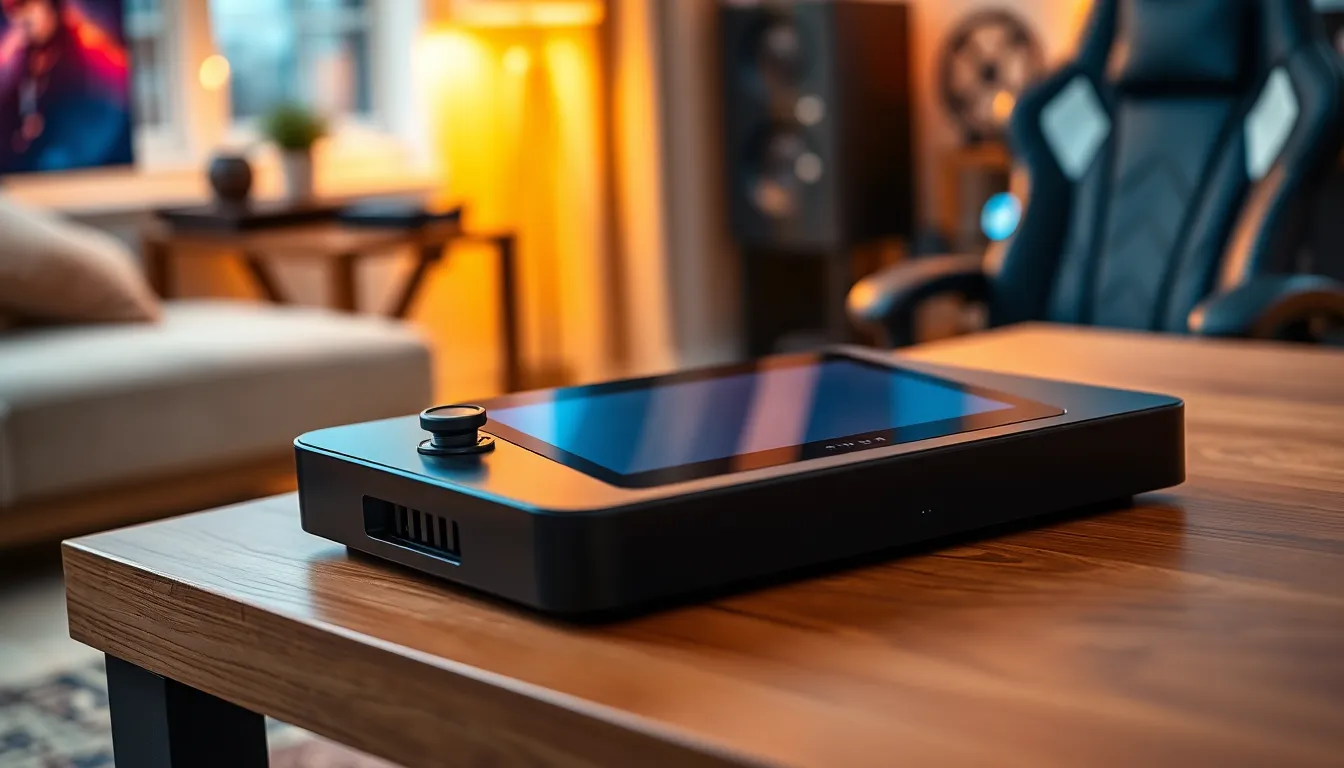Imagine cradling a gaming powerhouse in your hands, ready to unleash epic adventures anywhere you go. The Steam Deck isn’t just a portable console; it’s a ticket to gaming freedom, and its performance is nothing short of remarkable. With the ability to run AAA titles smoothly and a library of games at your fingertips, it’s like having a gaming rig that fits in your backpack.
But how does it stack up against the competition? Can it handle the heat of intense gameplay without breaking a sweat? Dive into the world of Steam Deck performance, where graphics meet portability, and discover why this device is turning heads and raising eyebrows. Get ready to level up your gaming experience and find out if the Steam Deck is the ultimate handheld for serious gamers.
Table of Contents
ToggleOverview of Steam Deck Performance
Steam Deck performance showcases its capacity to run demanding titles effortlessly. Equipped with a custom AMD APU, it combines a Zen 2 CPU and RDNA 2 GPU to deliver impressive graphics and processing power. This hardware arrangement allows the device to handle popular AAA games without compromising visual quality.
Frame rates vary based on the game’s settings and resolution. Typically, many gamers report smooth performance at 30 to 60 frames per second. Optimization options provide players the ability to tweak settings for enhanced frame rates or visual fidelity, depending on personal preferences.
Battery life plays an essential role in gaming performance. Users experience anywhere from 2 to 8 hours of gameplay, depending on usage and game intensity. Simple titles extend battery life significantly, while graphically intense games consume resources quickly, affecting longevity.
Cooling solutions also contribute to overall performance stability. The Steam Deck features an efficient cooling system that prevents overheating during lengthy gameplay sessions. Performance throttling is minimized, allowing for consistent gameplay experiences across various titles.
Storage options include both SSD and expandable microSD card support. Fast loading times enhance gameplay immersion, and players appreciate the flexibility to add more storage as needed. This adaptability helps the Steam Deck maintain a high performance standard.
Shader compilation plays a crucial role in performance. In-game stuttering occurs when the system compiles shaders on the fly, but Valve has implemented solutions to alleviate this issue. Adaptive loading processes reduce disruptions, ensuring a smoother gaming experience.
Overall, the Steam Deck stands out for its ability to balance power and portability, appealing to gamers who need high performance without sacrificing convenience.
Hardware Specifications

The Steam Deck features impressive hardware that enhances its gaming performance and user experience.
Processor and GPU
A custom AMD APU powers the Steam Deck, showcasing a Zen 2 CPU paired with an RDNA 2 GPU. This optimized combination provides substantial processing and graphical capabilities. Many gamers report achieving smooth gameplay at frame rates ranging from 30 to 60 FPS. The APU architecture ensures efficient handling of demanding games, making high-quality graphics more accessible on a portable device. It also allows for impressive heat management, which contributes to sustained performance during extended gaming sessions.
RAM and Storage
With 16 GB of LPDDR5 RAM, the Steam Deck supports multitasking and high-speed gaming experiences. This ample memory facilitates smooth operation even with resource-intensive applications. Storage options include a 512 GB NVMe SSD and support for expandable microSD cards, offering flexibility in game library management. Quick load times result from the SSD, enhancing user engagement and immersion. By accommodating different storage capacities, gamers can choose configurations that best fit their needs and play styles.
Gaming Performance
Steam Deck delivers impressive gaming performance, seamlessly running AAA titles and providing an engaging portable gaming experience.
Frame Rates and Resolution
Frame rates often range from 30 to 60 frames per second, ensuring gamers enjoy smooth visuals during intense gameplay. The device supports various resolutions, enabling adjustments to optimize performance for different titles. Players can experience stunning graphics and responsive controls, even in demanding scenarios. High settings may impact battery life, but many gamers find the trade-off worthwhile for enhanced visual detail. Settings can be fine-tuned to strike a balance between performance and quality, catering to individual preferences.
Game Compatibility
Steam Deck offers access to an extensive library of games, supporting both AAA titles and indie gems alike. The compatibility with Steam’s catalog allows gamers to play their existing libraries on the device, which enhances its appeal. Valve’s Proton compatibility layer enables many Windows games to run without significant issues. Gamers report success with various genres, from action-packed shooters to immersive role-playing games. Continuous updates improve game compatibility further, ensuring more titles remain playable over time.
Performance Optimization
Optimizing performance on the Steam Deck enhances gameplay and ensures a smoother experience. Key factors include regular software updates and adjusting settings appropriately.
Software Updates and Patches
Software updates play a significant role in improving the Steam Deck’s performance. Valve frequently releases patches that fix bugs and enhance stability, leading to smoother gameplay. Users report noticeable enhancements in frame rates and reduced stuttering after applying updates. The community benefits from ongoing support as developers prioritize game compatibility and performance improvements. Many gamers find that staying up-to-date ensures the best experience possible on their device.
Settings and Configurations
Adjusting settings enhances performance, allowing customization for various titles. Lowering graphics settings can significantly improve frame rates in demanding games. Users can also tweak resolution settings to find their ideal balance between visuals and performance. Configuring power profiles optimizes battery life during play, ensuring longer gaming sessions. Each title might require unique settings, so exploring in-game options can yield better performance without sacrificing quality.
Battery Life Considerations
Battery life is a crucial aspect of the Steam Deck experience. Users report gameplay ranging from 2 to 8 hours, depending on how demanding the titles are and the settings configured. Shorter play sessions often occur with graphically intensive games on high settings, impacting overall battery performance. On the other hand, lighter titles or lower graphics settings can significantly extend battery life.
Optimizing game settings enhances power efficiency. Adjusting graphics to medium can yield a better balance between battery longevity and visual fidelity. Power profiles can provide options for users to prioritize battery life during extended sessions. For instance, gamers frequently find that lowering the screen brightness contributes to saving battery power while still enjoying gameplay.
The Steam Deck’s efficient cooling system supports extended playtime. By preventing overheating during immersive gaming experiences, it helps maintain consistent performance, contributing to battery efficiency. Valve’s ongoing software updates also play a role in this aspect, as they often include enhancements that optimize power consumption.
Choosing the right storage option affects gaming performance as well. Fast-loading NVMe SSDs can offer substantial benefits in terms of performance without heavily impacting battery life. Gamers can balance storage requirements and play style to optimize both access speed and battery longevity.
Understanding battery life considerations is vital for maximizing the Steam Deck gaming experience. With proper settings adjustments and strategic choices, users can enjoy hours of gameplay while effectively managing battery life.
The Steam Deck redefines portable gaming with its impressive performance and extensive game library. Its custom AMD APU and 16 GB of RAM enable smooth gameplay across a range of titles while maintaining stunning graphics. Gamers can enjoy the flexibility of adjustable settings to optimize their experience, ensuring they get the most out of demanding games.
Battery life remains a crucial factor, and with thoughtful adjustments, users can extend their playtime significantly. The efficient cooling system further enhances its longevity during intense sessions. With continuous updates and a commitment to compatibility, the Steam Deck stands as a powerful choice for gamers seeking both performance and convenience in a portable format.








